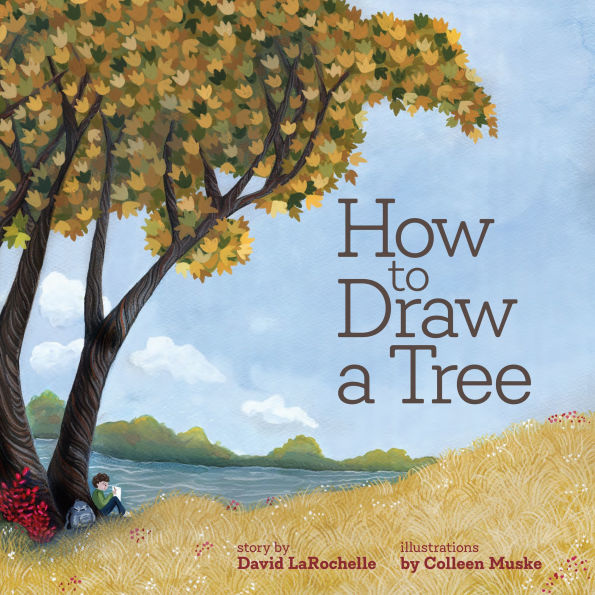Would you like to draw a tree? Here’s how. First you’ll need to make friends with your tree. Feel it. Smell it. Listen to it. Look at your tree from close up and far away. Notice all the things that make your tree special, from the shape of its leaves to the variety of colors hidden within.
There are so many words that could describe a tree:
prickly, shimmery, scraggly, squat,
ancient, graceful, crooked, proud.
What words would you choose?
All these details will help when you sit down to draw your tree. You can show everything you observed, from color to texture to shape. Then you can introduce your tree to others—using your words and your artwork.
Every tree is unique, and there are many different kinds. The pages of How to Draw a Tree show a wide array of species, with the name for each tucked into the illustrations, encouraging readers to slow down, appreciate, and learn.
Through direct questions and lively examples, longtime children’s book author David LaRochelle invites readers to explore their natural surroundings. Colleen Muske’s whimsical, vibrant illustrations help readers see trees in a new light. Drawing a tree involves getting to know your subject before even picking up a pencil. The more you look, the more you see. Beyond an art or science lesson, this book encourages young artists to go outside and spend time in nature, exploring firsthand what they plan to draw.
Would you like to draw a tree? Here’s how. First you’ll need to make friends with your tree. Feel it. Smell it. Listen to it. Look at your tree from close up and far away. Notice all the things that make your tree special, from the shape of its leaves to the variety of colors hidden within.
There are so many words that could describe a tree:
prickly, shimmery, scraggly, squat,
ancient, graceful, crooked, proud.
What words would you choose?
All these details will help when you sit down to draw your tree. You can show everything you observed, from color to texture to shape. Then you can introduce your tree to others—using your words and your artwork.
Every tree is unique, and there are many different kinds. The pages of How to Draw a Tree show a wide array of species, with the name for each tucked into the illustrations, encouraging readers to slow down, appreciate, and learn.
Through direct questions and lively examples, longtime children’s book author David LaRochelle invites readers to explore their natural surroundings. Colleen Muske’s whimsical, vibrant illustrations help readers see trees in a new light. Drawing a tree involves getting to know your subject before even picking up a pencil. The more you look, the more you see. Beyond an art or science lesson, this book encourages young artists to go outside and spend time in nature, exploring firsthand what they plan to draw.

How to Draw a Tree
32
How to Draw a Tree
32Hardcover

Product Details
| ISBN-13: | 9781681343211 |
|---|---|
| Publisher: | Minnesota Historical Society Press |
| Publication date: | 08/05/2025 |
| Pages: | 32 |
| Product dimensions: | 10.20(w) x 10.20(h) x 0.50(d) |
| Age Range: | 3 - 7 Years |
